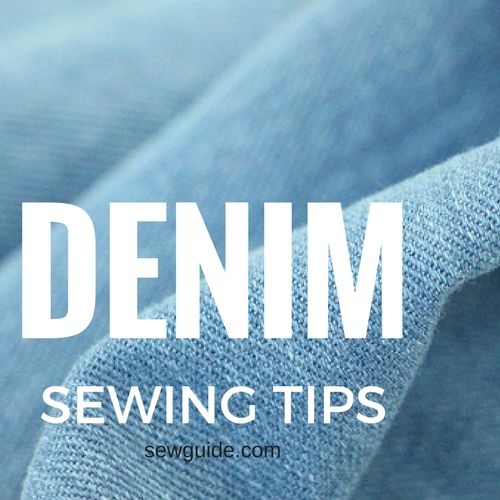
When a beginner starts to sew, denim is not the first fabric choice. Everyone has a perception that it is a hard fabric to sew. What they don’t know is that there are many types of denim, including dress-weight denim, which are quite easy to sew. Yes, if you are sewing jeans, it can pose some challenges because of its fabric-weight and thick seams.
Denim fabric is not only the choice of wear of the masses; the fabric is the favorite of many top-level designers too. Other than the wardrobe staple jeans, Jackets, bags, vests, skirts, tops, and even shawls – there is no end to what you can sew with denim.
The beginner home sewer usually needs help imagining sewing with denim fabric when all they have seen is the jeans. It does look tough to emulate the sewing done in professionally made jeans. But with some tips and techniques, you can sew denim comfortably at home.
One advantage of denim is that it is made of cotton fibers. Denim comes in many weights. The lightweight denim is as easy to sew as any cotton fabric. Heavier denim may be slightly difficult to sew but nothing is impossible if you take care of a few things.
Like using a Polyester or cotton-wrapped polyester thread and heavy-duty or denim needle (No.16) on your sewing machine. Use top stitching thread for the beautiful stitching on denim or use two spools at once. More tricks are mentioned below:
Check out the post on different denim fabric
Can I sew denim on my regular sewing machine?
- Can I sew denim on my regular sewing machine?
- How do I cut denim ?
- Which thread should I use for sewing denim ?
- Which needle should I use when I sew denim?
- Should I prewash denim ?
- How to finish the fabric edges of denim?
- How to sew seams when sewing denim ?
- 8. How to sew denim by hand ?
- 9. What machine settings should I use when sewing denim?
- 10. How to embroider on denim?
Yes, you can, i.e., if you use regular dress-weight denim and only attempt to sew a few layers of the fabric at a time. For, e.g. the hem of jeans.
You need a sturdy enough sewing machine, not the flimsy kind you get cheaply. You will need a heavy-duty and sturdy machine to sew many layers of thick denim, like the jeans’ hem at the seam; the industrial machines do this quickly enough.
You may have to take it a little slowly with your regular machine, change the needle to the appropriate one for a thicker fabric. With the right needle and a good quality thread and some patience, your home sewing machine can work very well with the denim fabric, provided there are not many layers.
A walking foot or an even feed foot is a great accessory to have when sewing denim.
The roller feet is also said to be easy on denim.
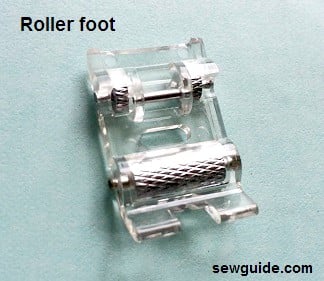
If you plan to work with heavyweight denim regularly and want to sew multiple layers at once ( like around that front fly and zipper), you are better off with a commercial/industrial grade sewing machine. You will need to buy a machine designed for sewing very heavy threads used for topstitching and stitching layers of denim.
Check out this post on buying industrial sewing machines.
One way to use heavy thread with your regular sewing machine is to sew the heavy thread in the bobbin and use a regular size thread in the top needle.
How do I cut denim ?
When cutting denim pattern pieces, ensure that the directional ribbing in its surface is consistent and in one direction. This nap should be followed for all pattern pieces for the whole garment to look good.
Use the sharpest cutting tool you have for cutting denim. Rotary cutters and scissors work equally well.
Which thread should I use for sewing denim ?
Polyester thread or cotton covered polyester thread is sturdy enough for denim stitching. Eg: Gutermann Thread Denim 6 SPLS Denim Multicoloured is a 100% polyester thread in colors which are used for jeans stitching.
You can also use top-stitching thread to sew denim; if you do not have top-stitching thread, use two spools of thread at once to get the effect of a thicker thread.
Your sewing machine may have an extra spool pin; attach it and thread the sewing machine and the needle with both the thread from the spools as one.
Usually, a contrast color like orange is used for topstitching denim fabric in jeans. Your choice of thread color would depend on the effect you want on the garment. I think a bright contrasting color would be good (like yellow, pink, or lime green). You will have to try it on a scrap piece of fabric because denim fabric comes in various shades, and a color that looks good against a hue of indigo may not look the same on another shade of blue.
Buttonhole twist is also ideal as a topstitching thread because of its strength and attractive sheen.
When using a heavy thread on the top thread spool, use the regular thread in the bobbin.
Which needle should I use when I sew denim?
Denim is best sewn with a special Denim/jeans needle available in sewing supply stores. These needles have a bigger eye to accommodate the thicker thread used to sew denim and are longer and sharper. If you are using stretch denim, you may need a stretch needle.
One handy tip is to keep some extra denim needles (usually No. 16 needles) at hand when sewing with denim especially if you are completing a fairly big project. Denim requires very sharp needles and sewing denim dulls the needles very quickly.
Also, another very important point to note is that you should only go slowly when sewing denim. Sewing very fast will result in needle breakage and frustrations all around. Go slow with speed.
Should I prewash denim ?
Denim, as a fabric made of cotton fibers, will shrink with washing and may sometimes run color too. So it is only common sense that you prewash this fabric.
You should ask the store whether the denim you buy is Sanforized. Sanforized denim has been prewashed/pretreated so that shrinkage is minimal ( as low as 1%).
So sanforized denim can be put to the test of sewing without washing without much undue damage. But even then, there may be sizing in the fabric which may make it difficult for you to sew.
You may prefer raw denim, which is unsanfronized; many people do. Raw denim, with its deep color, is very attractive, and some think that whatever fading is there in denim, It should come naturally, not through any chemical process.
And raw denim has to be prewashed (no option here). The fabric should be soaked in a full tub of water for some time and then hung to dry before sewing. You can also put in the washing machine. Some even recommend prewashing it three times – because denim continues to shrink.
Denim fabric edges ravels. So if you take denim fabric from the bolt and wash it as it is, you may have an unraveled mess in your hands, especially if you have put it in the washer. An easy way out is to use your pinking shears on the edges.
You can also use basting stitches to stitch the fabric edges together, make it into a tube, and then wash it. The basting stitches will come off easily enough after the cloth is washed, and the edges will remain intact.
How to finish the fabric edges of denim?
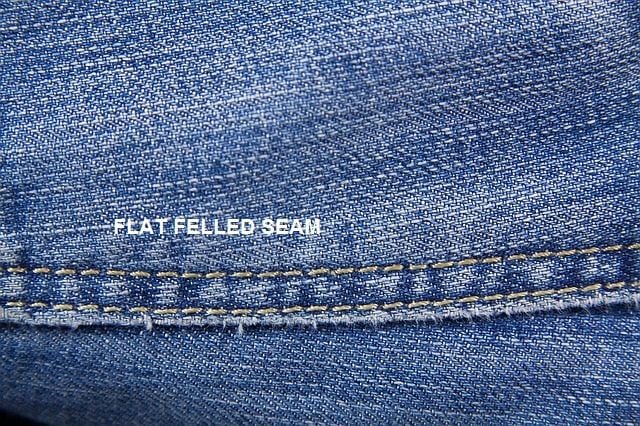
Selvage denim comes with fabric edges finished with a very bright-colored band. But other denim fabric will have to have the fabric edges finished, as the denim frays a lot.
In jeans, a flat felled seam finish is most commonly used. This seam finish encloses the fabric edge as well. But this is very difficult on an ordinary sewing machine, especially if you are sewing with heavyweight denim.
An overcast stitch / serger is used otherwise to finish the fabric edges of denim . You can also use pinking shears, as this cutting tool will give a zig zag edge to the edges making fraying impossible. Some of the fabric edge finishes may prove to be unsuitable for denim because of its heavy nature.
A self-fabric fringe is a very attractive fabric edge finish for denim. I have a pair of shorts with this finish, and it is absolutely gorgeous. Checkout this post on making fringes to see how it done.
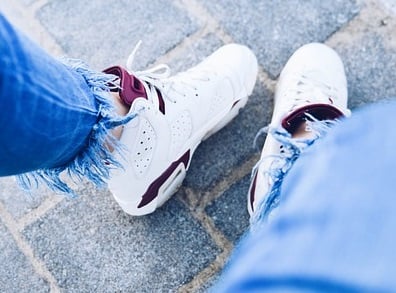
How to sew seams when sewing denim ?
Denim jean seams are usually done with a flat felled seam. Checkout the post on 17 different types of seams for more details on sewing this seam.
If you are using a regular seam, you will have to trim the seams to avoid bulk, especially the seam allowances of facings. Clipping seam allowances every 1 inch, especially for curvy seams, and grading the seam allowances are all necessary when sewing with denim.
It is better if you use a lightweight fabric as a facing so that you do not have to deal with two layers of denim fabric. Even the hem can be finished in this way.
Always press the seams open especially if you are crossing seams. You can use the steam setting in your iron to make the seams behave. Some even use the hammer on the seams – cruel I say- but whatever works.
Denim is a very thick fabric. You do not have to line dresses made with denim. But if you have to, choose lightweight fabric as the lining material.
Do interface buttonholes and behind buttons.
Most Denim clothes have Bar tacks on high-stress areas like the top of pockets- Set your machine for a narrow zigzag, and a very short stitch length. Sew for ¼” and reverse to reinforce.
Hemming jeans – It is a good idea to make the hem of denim garments at least about 1″ wide and double topstitch at the top of the hem to prevent the hem from curling up.
Related posts : Hem a jeans -different ways ; Different types of Denim ; Different parts of a pair of jeans.
8. How to sew denim by hand ?
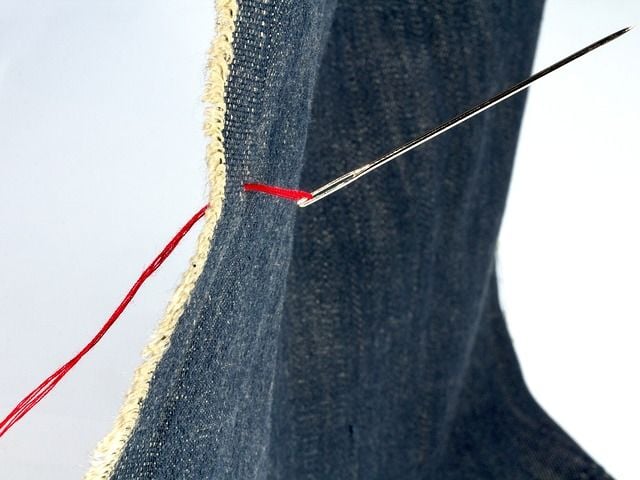
Sewing denim with hand stitches is a test of your patience. But sometimes you have to.
One instance where I sew denim with hand stitches is when I sew up the hem of my kids’ pants. My younger one inherits my eldest’s jeans, and sometimes they are overlong. I do not want to cut away the hem of these jeans as I know she will wear the jeans for a long time and I may have to let in the stitches after some time.
Even with a seam ripper, it is difficult to cut a seam in jeans. So I use the method outlined in this post on hemming jeans but instead of sewing machine I sew the hem with a hand sewing needle and thread.
I always use the best quality thread when hand sewing denim. Do not want thread breaking up every now and then. Stitch denim with a sharp, long, big eyed needle.
9. What machine settings should I use when sewing denim?
Increase the stitch length to 3.5 -4 when sewing denim. At times you may even have to navigate thick seams with the turn of the hand wheel.
Related post : Sewing with thick fabrics on ordinary sewing machine; Jeans Repairs
10. How to embroider on denim?
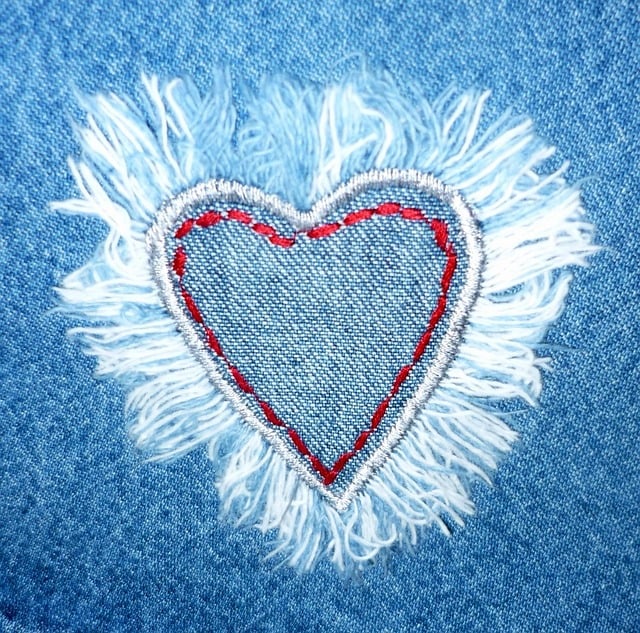
Machine embroidery on denim looks absolutely fantastic when done with the right colored thread. But it is difficult to do on an already completed or store-bought garment. Here Hand embroidery works great. Check out this post on DIY Embroidered jeans for some ideas on designs and the best positions for the embroidery.
Embroidering letters on denim can be done with your simple machine with a zig zag stitch and will bring a nice personal touch to the denim.
Checkout this post on many ways of sewing patches on jeans and other clothing and How to make a knee ripped jeans (without removing the white threads in denim) and 15 different ways to distress denim jeans
Because of its thickness the fabric may have some difficulty to hoop on the embroidery hoop prior to stitching. Another problem is the thickness of the seams – getting the hoops around these seams are a challenge. Some kind of lightweight tear away/cut away stabilizer may have to be applied on the back for some stability while embroidering
There are many ways you can embellish denim. Embroidery for one. Here is a post on jeans embroidery. Some of the other methods are listed in the post on embellishing and decorating jeans.
Denim is a thick fabric but Couching is an embroidery which can easily be done on denim. Even thick metallic threads can be used to embellish denim with couching. Checkout the post on 4 ways of doing couching stitches.
Related posts : How to alter too short jeans; How to alter too tight jeans; How to make patchwork jeans.



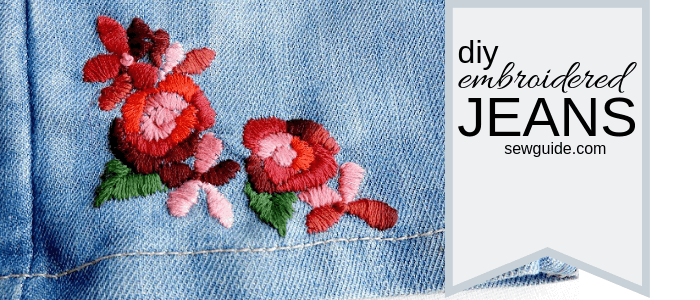
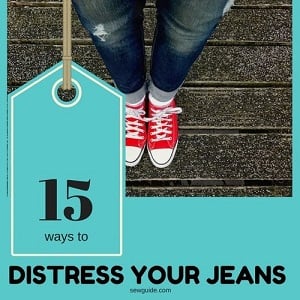
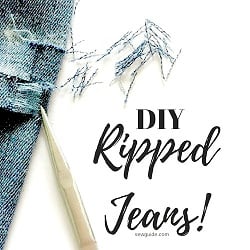
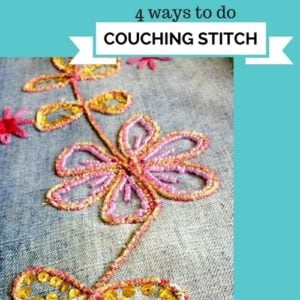

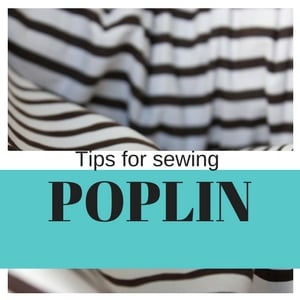
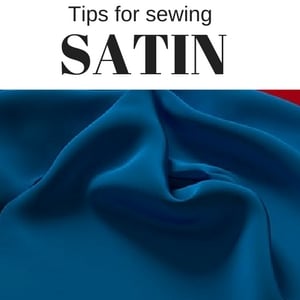
Hey! I know I’m quite late to this so maybe this is a long shot but-
I want to sew a pair of jeans with a half-elasticated waistband, but I am confused as to what denim weight I should choose for this. I’ve been told that mid-weight is the best, but I’m concerned of the comfort the waistband will have since the midweights (11-13 oz?) I’ve seen so far seem like they’d be too stiff for the elasticated part to be comfortable/non-irritating on the skin. Can you please suggest me what weight would be the best? Thank you!
Is there any way replicate the thick white big stitching that is commonly seen on Miss Me and Vigoss jeans – at home?
I have about 20 pairs of jeans that I took into be professionally hemmed while leaving the factory hemline (big stitching) intact. However, the seamstress “forgot” and now all my designer jeans came back home with the “grandma hem” – they were cut off and literally folded inward, ironed and hemmed with Levi’s orange thread…even though the rest of the jeans (above the ankle) have the thick white stitching all over.
I would love to be able to correct this – to at least make the stitches match. They just look so…off right now.
Thanks in advance for your help!
Hi Sheila
So unfortunate. I think it is going to cost you more to get them to rip all the thread out and then re-stitch it – alteration itself is costly. You can try to do it yourself- buy top stitching/denim thread in white and a sturdy needle and try stitching on one. The regular cotton thread wouldnot do. it is too thin and anyways after sometime it will look invisible. If you cannot get thick top stitching thread, try using two spools of polyester thick thread. some tips are here – but more useful if you where doing it from scratch https://sewguide.com/how-to-hem-jeans/
YouTube tutorial. Hem keeping the original hem. I’ve tried to replicate by hand, so so results. I’m trying this way now.
Thanks so much for this great information when sewing denim! I’ve been sewing for years, but usually with silks and chiffon and learning these tips when sewing with denim are wonderful!